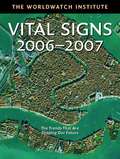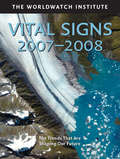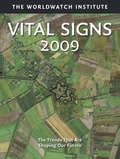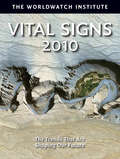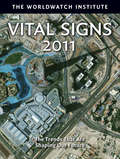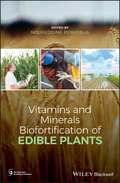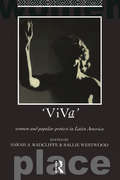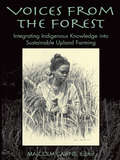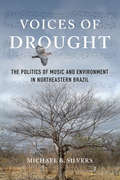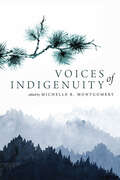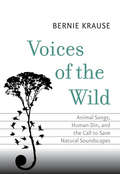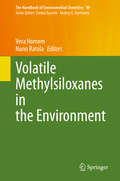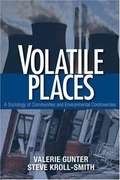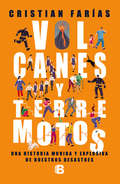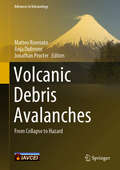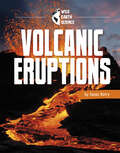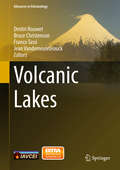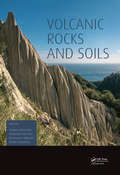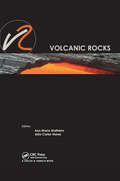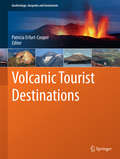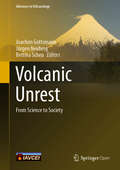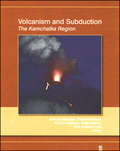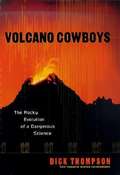- Table View
- List View
Vital Signs 2006-2007
by The Worldwatch InstituteThis report tracks and analyzes 44 trends that are shaping our future, and includes graphs and charts to provide a visual comparison over time. Categories of trends include: Food, Agricultural Resources, Energy and Climate, Global Economy, Resource Economics, Environment, War and Conflict, Communications and Transportation, Population and Society, and Health and Disease.
Vital Signs 2007-2008 (Vital Signs)
by The Worldwatch InstituteThis report tracks and analyzes 44 trends that are shaping our future, and includes graphs and charts to provide a visual comparison over time. Categories of trends include: Food, Agricultural Resources, Energy and Climate, Global Economy, Resource Economics, Environment, Conflict and Peace, Communications and Transportation, Population and Society, and Health and Disease.
Vital Signs 2009 (Vital Signs)
by The Worldwatch InstituteThis sixteenth volume of Worldwatch's Vital Signs series makes it clear that climate change is both a growing driver of and an increasingly important motivator behind the world's leading economic, social, and environmental trends
Vital Signs 2010 (Vital Signs)
by The Worldwatch InstituteThis seventeenth edition of the Worldwatch Institute series shows that climate change continues to cast a long shadow over the world's leading economic, social, and environmental trends.
Vital Signs 2011 (Vital Signs)
by The Worldwatch InstituteThis eighteenth volume of the Worldwatch Institute series makes it clear that the Great Recession affects many of the world's leading economic, social, and environmental trends - but that the impact can be very different by country.
Vitamins and Minerals Biofortification of Edible Plants (New York Academy of Sciences)
by Noureddine BenkebliaA Detailed Reference on How Modern Biotechnology is using the Biofortification of Crops to Improve the Vitamin and Mineral Content of Edible Plants In this reference, Vitamins and Minerals Bio-Fortification of Edible Plants, authors cover new territory on phytonutrients, focusing on the enhancement and modification of edible crops. This book presents techniques and research findings from modern biotechnology to educate readers on the newest tools and research in the field. Readers will learn how groundbreaking scientific advances have contributed to the nutritional content of edible plants and crops for animals and humans. Inside, readers will find comprehensive information on new concepts of biofortification, including but not limited to: ● Modern biotechnology and its uses for improving the vitamin and mineral content of edible plants ● Potential minerals and vitamins that can be targeted and implemented in agriculture ● Ways of enhancing the nutritional contents of edible plants to address nutritional deficiencies and improve livestock ● Methods of identifying plants that can be used to heal or prevent disease and illness While many books cover the phytonutrients of crops, this reference book reports on methodologies, techniques, and environmental changes used to enhance and improve agricultural products. It is one of the first to provide information on using modern biotechnologies to modify crops with the goal of creating health benefits.
Viva: Women and Popular Protest in Latin America. (Routledge International Studies of Women and Place)
by Sarah A. Radcliffe Sallie Westwood Dr Sallie WestwoodFirst published in 1993. Routledge is an imprint of Taylor & Francis, an informa company.
Voices from the Forest: Integrating Indigenous Knowledge into Sustainable Upland Farming
by Malcolm CairnsThis handbook of locally based agricultural practices brings together the best of science and farmer experimentation, vividly illustrating the enormous diversity of shifting cultivation systems as well as the power of human ingenuity. Environmentalists have tended to disparage shifting cultivation (sometimes called 'swidden cultivation' or 'slash-and-burn agriculture') as unsustainable due to its supposed role in deforestation and land degradation. However, a growing body of evidence indicates that such indigenous practices, as they have evolved over time, can be highly adaptive to land and ecology. In contrast, 'scientific' agricultural solutions imposed from outside can be far more damaging to the environment. Moreover, these external solutions often fail to recognize the extent to which an agricultural system supports a way of life along with a society's food needs. They do not recognize the degree to which the sustainability of a culture is intimately associated with the sustainability and continuity of its agricultural system. Unprecedented in ambition and scope, Voices from the Forest focuses on successful agricultural strategies of upland farmers. More than 100 scholars from 19 countries--including agricultural economists, ecologists, and anthropologists--collaborated in the analysis of different fallow management typologies, working in conjunction with hundreds of indigenous farmers of different cultures and a broad range of climates, crops, and soil conditions. By sharing this knowledge--and combining it with new scientific and technical advances--the authors hope to make indigenous practices and experience more widely accessible and better understood, not only by researchers and development practitioners, but by other communities of farmers around the world.
Voices of Drought: The Politics of Music and Environment in Northeastern Brazil
by Michael B. SilversIn Voices of Drought, Michael B. Silvers proposes a scholarship focused on environmental justice to understand key questions in the study of music and the environment. His ecomusicological perspective offers a fascinating approach to events in Ceará, a northeastern Brazilian state affected by devastating droughts. These crises have a profound impact on social difference and stratification, and thus on forró music in the sertão (backlands) of the region. At the same time, the complex interactions of popular music and social conditions also help create the environment. Silvers offers case studies focused on the sertão that range from the Brazilian wax harvested in Ceará for use in early wax cylinder sound recordings to the drought- and austerity-related cancelation of Carnival celebrations in 2014-16. Unearthing links between music and the environmental and social costs of drought, his daring synthesis explores ecological exile, poverty, and unequal access to water resources alongside issues like corruption, prejudice, unbridled capitalism, and expanding neoliberalism.
Voices of Indigenuity (Intersections in Environmental Justice)
by Michelle MontgomeryVoices of Indigenuity collects the voices of the Indigenous Speaker Series and multigenerational Indigenous peoples to introduce best practices for traditional ecological knowledge (TEK). In this edited collection, presenters from the series, both within and outside of the academy, examine the ways they have utilized TEK for inclusive teaching practices and in environmental justice efforts. Advocating for and providing an expansion of place-based Indigenized education that infuses Indigenous epistemologies for student success in both K–12 and higher education curricula, these essays explore topics such as land fragmentation, remote sensing, and outreach through the lens of TEK, demonstrating methods of fusing learning with Indigenous knowledge (IK). Contributors emphasize the need to increase the perspectives of IK within institutionalized knowledge beyond being co-opted into non-Indigenous frameworks that may be fundamentally different from Indigenous ways of thinking. Decolonizing current harmful pedagogical curricula and research training about the natural world through an Indigenous- guided approach is an essential first step to rebuilding a healthy relationship with our environment while acknowledging that all relationships come with an ethical responsibility. Voices of Indigenuity captures the complexities of exploring the contextu- alized meanings for why TEK should be integrated into Western environmental science processes and frameworks while rooted in Indigenous studies programs.
Voices of the Wild
by Bernie KrauseWild Soundscapes is the first comprehensive guide to listening to--and recording--nature. Learn how to tune in to nature's biophonies, or creature symphonies; how to use simple microphones to hear more; and how to record, mix, and play with sounds you gather. Keep it simple or launch yourself into a new creative field. Whether you're an amateur naturalist, novice field recordist, musician, want to create your own natural sound library, or just want to gain further appreciate of the natural world, this is the book for you. Bernie Krause, a professional field recordist and bioacoustician, shares his expertise in exploring nature's sonic landscapes. Wild Soundscapes comes with a full-length CD, narrated by Krause, sampling a variety of natural sounds: the crashing sea, the singing of ants, the bugling of Yellowstone elk, the plop of falling Costa Rican crabs, and more. With the help of this CD, Krause demonstrates techniques and tricks for field recording success.
Volatile Methylsiloxanes in the Environment (The Handbook of Environmental Chemistry #89)
by Vera Homem Nuno RatolaComprising 12 chapters, this book focuses on volatile methylsiloxanes (VMSs), the shorter-chained organosiloxanes, and reviews the main areas and environmental compartments where they have been found and studied. It opens with a detailed description of the structural and functional properties, toxic risks and possible transformations of VMSs in the environment and their main uses in various activities and products, as well as the identification of the main sources of emission. Further chapters examine the analytical strategies and protocols that have been used to address the quantification of VMSs, including the issue of possible cross-contaminations. The book also discusses the presence of VMSs in wastewater treatment plants (WWTPs) and in water bodies, their atmospheric fate and levels in biota, as well as occurrences of VMSs in remote areas of the world. It closes with a comprehensive conclusion and discussion on future directions for upcoming studies. This book is not intended as a finishing line, but rather as an important step towards improving our understanding of VMSs, to fuel new collaborations between research groups and/or with industry and lastly to convince more researchers to explore the mysteries of these ubiquitous, yet understudied, chemicals.
Volatile Places: A Sociology of Communities and Environmental Controversies
by Steve Kroll-Smith Valerie J. GunterVolatile Places: A Sociology of Communities and Environmental Controversies is a thoughtful guide to the spirited public controversies that inevitably occur when environments and human communities collide. The movie "An Inconvenient Truth" based on the environmental activism of Al Gore and the devastation of Hurricane Katrina are specifically highlighted. Authors Valerie Gunter and Steve Kroll-Smith begin with a simple observation and offer a provocative case study approach to the investigation of community and environmental controversies.
Volcanes y terremotos
by Cristián FaríasLibro de divulgación científica en un lenguaje ameno y directo sobre un tema que cada tanto es contingencia en Chile: los terremotos y las erupciones volcánicas. Farías dirige el centro de geofísica de la UTEM y desde el twitter y las columnas en La Tercera ha hecho una labor de divulgación que se recoge en esta crónica, la que aborda la historia y el comportamiento de volcanes y terremotos en Chile, tanto para el análisis de desastres pasados como también la previsión de eventos futuros, y la relación de estos fenómenos naturales con la población y sus ciudades.
Volcanic Debris Avalanches: From Collapse to Hazard (Advances in Volcanology)
by Matteo Roverato Anja Dufresne Jonathan ProcterThis book presents an overview of volcanic debris avalanche deposits, which are produced by partial volcanic edifice collapse, a catastrophic natural phenomenon. It has been 40 years since the volcanic debris avalanche associated with the 1980 eruption of Mount St. Helens, and our understanding of these events has grown considerably in the interim. Drawing on these advances, the book addresses all aspects of volcanic debris avalanches. Though previously overlooked in field-based geological and volcanological studies, these deposits are now known to be associated with most volcanoes and volcanic areas around the world. The book presents state-of-the-art ideas on the triggering and emplacement mechanisms of these events, supported by field and analogue studies, as well as new simulations tools and models used to determine their physical characteristic and hazards.
Volcanic Eruptions (Wild Earth Science)
by Isaac KerryA rumble deep inside Earth. Hot, flowing magma is trapped and needs a way to escape. Pressure builds and causes a break in the surface. Eruption! Volcanic eruptions can shoot lava, ash, and smoke over a huge area. Why do they happen? Learn about volcanoes, what causes them, and how to be prepared.
Volcanic Lakes
by Franco Tassi Dmitri Rouwet Bruce Christenson Jean VandemeulebrouckThis book aims to give an overview on the present state of volcanic lake research, covering topics such as volcano monitoring, the chemistry, dynamics and degassing of acidic crater lakes, mass-energy-chemical-isotopic balance approaches, limnology and degassing of Nyos-type lakes, the impact on the human and natural environment, the eruption products and impact of crater lake breaching eruptions, numerical modeling of gas clouds and lake eruptions, thermo-hydro-mechanical and deformation modeling, CO2 fluxes from lakes, volcanic lakes observed from space, biological activity, continuous monitoring techniques, and some aspects more. We hope to offer an updated manual on volcanic lake research, providing classic research methods, and point towards a more high-tech approach of future volcanic lake research and continuous monitoring.
Volcanic Rocks and Soils
by Tatiana Rotonda, Manuela Cecconi, Francesco Silvestri and Paolo TommasiVolcanic rocks and soils show a peculiar mechanical behaviour at both laboratory and in-situ scale due to their typical structural characters. Volcanic rocks and soils contains keynote lectures and papers from the International Workshop held in Ischia (Italy), 24-25 September 2015. The book deals with recent developments and advancements, as well as case histories, in the geotechnical characterization and engineering applications related to volcanic formations. It covers a variety of themes, including: • Geotechnical characterization under both static and cyclic/dynamic loading conditions, with special regard to structural properties at different scales (microstructural features; field and laboratory characterization; construction materials); • Geotechnical aspects of natural hazards (slope stability; seismic risk); • Geotechnical problems of engineering structures (foundations; embankments; excavations and tunnels). Volcanic Rocks and Soils is of interest to scientists and practitioners in the fields of rock and soil mechanics, geotechnical engineering, engineering geology and geology.
Volcanic Rocks: Proceedings of ISRM Workshop W2, Ponta Delgada, Azores, Portugal, 14-15 July, 2007
by Ana Maria MalheiroEnvironmental issues are high on the public agenda and engineering projects need to take environmental concerns on board. Volcanic Rocks, contains papers from the ISRM Workshop W2 (Ponta Delgada, Azores, Portugal 14-15 July 2007), and focuses specifically on problems associated with construction activities in areas of volcanic rock. Volcanic Rocks highlights novel approaches and solutions to engineering problems in volcanic areas, covering a variety of topical themes, which include: characterization of volcanic formations; case studies; construction materials; earthquake engineering and rock dynamics; foundations; slope stability, and tunnelling.
Volcanic Tourist Destinations
by Patricia Erfurt-CooperThis comprehensive book addresses the pressing need for up-to-date literature on volcanic destinations (active and dormant) and their role in tourism worldwide in chapters and case studies. The book presents a balanced view about the volcano-based tourism sector worldwide and discusses important issues such as the different volcanic hazards, potential for disasters and accidents and safety recommendations for visitors. Individual chapters and case studies are contributed by a number of internationally based co-authors, with expertise in geology, risk management, environmental science and other relevant disciplines associated with volcanoes. Also covered are risk aspects of volcano tourism such as risk perception, risk management and public safety in volcanic environments. Discussions of the demand for volcano tourism, including geotourism and adventure tourism as well as some historical facts related to volcanoes, with case studies of interesting socio-cultural settings are included.
Volcanic Unrest: From Science To Society (Advances In Volcanology Ser.)
by Joachim Gottsmann Jürgen Neuberg Bettina ScheuThis open access book summarizes the findings of the VUELCO project, a multi-disciplinary and cross-boundary research funded by the European Commission's 7th framework program. It comprises four broad topics:1. The global significance of volcanic unrest2. Geophysical and geochemical fingerprints of unrest and precursory activity3. Magma dynamics leading to unrest phenomena4. Bridging the gap between science and decision-makingVolcanic unrest is a complex multi-hazard phenomenon. The fact that unrest may, or may not lead to an imminent eruption contributes significant uncertainty to short-term volcanic hazard and risk assessment. Although it is reasonable to assume that all eruptions are associated with precursory activity of some sort, the understanding of the causative links between subsurface processes, resulting unrest signals and imminent eruption is incomplete. When a volcano evolves from dormancy into a phase of unrest, important scientific, political and social questions need to be addressed. This book is aimed at graduate students, researchers of volcanic phenomena, professionals in volcanic hazard and risk assessment, observatory personnel, as well as emergency managers who wish to learn about the complex nature of volcanic unrest and how to utilize new findings to deal with unrest phenomena at scientific and emergency managing levels. This book is open access under a CC BY license.
Volcanism and Global Environmental Change
by Anja Schmidt Kirsten E. Fristad Linda T. Elkins-Tanton Anja Schmidt Kirsten E. FristadCovering a key connection between geological processes and life on Earth, this multidisciplinary volume describes the effects of volcanism on the environment by combining present-day observations of volcanism and environmental changes with information from past eruptions preserved in the geologic record. The book discusses the origins, features and timing of volumetrically large volcanic eruptions; methods for assessing gas and tephra release in the modern day and the palaeo-record; and the impacts of volcanic gases and aerosols on the environment, from ozone depletion to mass extinctions. The significant advances that have been made in recent years in quantifying and understanding the impacts of present and past volcanic eruptions are presented and review chapters are included, making this a valuable book for academic researchers and graduate students in volcanology, climate science, palaeontology, atmospheric chemistry, and igneous petrology.
Volcanism and Subduction
by Pavel Izbekov Evgenii Gordeev Jonathan Lees Minoru Kasahara John EichelbergerPublished by the American Geophysical Union as part of the Geophysical Monograph Series, Volume 172.The Kamchatka Peninsula and contiguous North Pacific Rim is among the most active regions in the world. Kamchatka itself contains 29 active volcanoes, 4 now in a state of semi-continuous eruption, and I has experienced 14 magnitude 7 or greater earthquakes since accurate recording began in 1962. At its heart is the uniquely acute subduction cusp where the Kamchatka and Aleutian Arcs and Emperor Seamount Chain meet.Volcanism and Subduction covers coupled magmatism and tectonics in this spectacular region, where the torn North Pacific slab dives into hot mantle. Senior Russian and American authors grapple with the dynamics of the cusp with perspectives from the west and east of it, respectively, while careful tephrostratigraphy yields a remarkably precise record of behavior of storied volcanoes such as Kliuchevskoi and Shiveluch. Towards the south, Japanese researchers elucidate subduction earthquake processes with unprecedented geodetic resolution. Looking eastward, new insights on caldera formation, monitoring, and magma ascent are presented for the Aleutians.This is one of the first books of its kind printed in the English language. Students and scientists beginning research in the region will find in this book a useful context and introduction to the region's scientific leaders. Others who wish to apply lessons learned in the North Pacific to their areas of interest will find the volume a valuable reference.
Volcano Cowboys: The Rocky Evolution of a Dangerous Science
by Dick ThompsonTwenty years ago, Mt. St. Helens, in Washington State, "blew. " It was the volcano's first eruption in recorded time, although as early as 1978 a team of scientists from the US Geological Survey had labeled it "the most dangerous volcano in the Cascade Range. " In June 1991, Mt. Pinatubo in the Philippines spewed forth its own mix of ash, gases, mud, lava, and all the other debris that had been building within the mountain for centuries. Between those two events, USGS scientists had been working at warp speed to learn more about predicting violent eruptions. Data from the nation's only Volcano Center was not helpful. Work there centered on volcanoes that responded to interior pressure by quietly releasing a slow-moving flow of lava, rather than spewing its entrails out in a blast. Survey members were presented with a rare opportunity when Mt. St. Helens showed signs of activity. Camped on the mountains flanks, daring the crater itself, they dug out rocks, tended recorders, began to learn how to use newly developed instruments. Here was an active volcano, believed to be on the verge of eruption by some, if not all, experts. Along with new instruments they had computer programs that saved them days and weeks of work. They learned techniques that revealed the dates of previous major eruptions and provided patterns for future predictions. After the eruption, studying Mt. St. Helens and other volcanoes, they learned more and more. By the time a newly-active Pinatubo threatened tens of thousands of villagers and the U. S. military's Clark Air Force Base, the men of the USGS were far better able to feel secure in urging local authorities and the Air Force brass to evacuate. It was still a gamble, but the odds were far better. And the work goes on. Thompson, a veteran science reporter for Time Magazine, spent many hours with the relative handful of scientists whom he calls "volcano cowboys. " (Considering their lifestyle and their rugged "laboratories" - the volcanoes themselves - the sobriquet is earned. ) They have loaned him their field notes, and one geologist gave him his as yet unpublished autobiography. The vivid material and Thompson's skill in bringing a good story to life has resulted in a book that celebrates these "cowboys" their tough and hazardous lives and the often harrowing decisions they must make.
